Understanding the device that an advert is being displayed on and tracking an individual across multiple devices is not the same thing. The concepts are commonly confused or used interchangeably. Both must be mastered – and combined with fast and accurate supporting technology and data – to achieve a truly effective campaign. Understanding the complexities, limitations, and legalities of each are an essential skill for all marketing professionals.
This 101, written by James Rosewell, founder and CEO of 51Degrees, explains why and how different devices can be targeted to maximize ROI for advertisers and publishers. It discusses the complexity associated with tracking individuals and the steps being taken to disable or limit such tracking.
If you think iOS users are more valuable than Android, then you’re missing data and profit. This 101 is for you.
Introduction
People interact with multiple devices every day. Whether it’s starting the day with a cup of coffee whilst listening to music via a smart speaker and checking the morning’s news on a tablet. Or using a smartphone to catch up with social media on the way to and from work or the shops. Receiving important notifications via a smartwatch. Or ordering clothes on a tablet before sitting down in front of a television to catch up on a favourite box set. It’s quite reasonable for a single person to use five or six different devices to fulfil their daily digital needs.

Creating the frictionless personalised experience across multiple devices popularised in science fiction is the holy grail for marketing, publishing and technology professionals.
The reality is somewhat different, as competing technologies, technology vendors, technology limitations, government regulators and people’s appetite for personalised experiences degrade a vision that technically is achievable today.
Those seeking a truly rewarding engagement with real people need to understand the causes of good and bad experiences across multiple devices. They must adopt strategies, technologies and most of all a mindset to achieve truly rewarding outcomes.
Advertisers will understand which features to demand from their Ad tech and publisher partners.
Publishers will learn how to make their platforms multi device-aware and in turn generate more rewarding experiences.
Ad tech businesses will understand which features to abandon and which to improve.
This 101 explains why engagement varies across devices; the role of tracking and advertising technologies; and the components of a successful strategy, all interspersed with simple tips.
It is presented in four sections.
1. Device – what?
2. Personalise – who?
3. Platform – how?
4. Summary
Disclaimer: Mobile Marketing Magazine, it’s authors and guest columnists are not lawyers and legal advice should be sought before relying on any content or recommendations as specific situations vary.
Device – what?
Before jumping to personalisation, understanding the differences between types of device is paramount. Devices are used in different ways, broadly irrespective of the age, gender or lifestyle preferences of a person.
For commercially-minded businesses, statistics show web traffic in western economies is split roughly 50/50 between mobile and non-mobile. In emerging economies, the split is skewed to mobile. Different devices do not perform equally. According to CPC strategy, a digital strategy consultant, 3.9 per cent of shoppers on desktop convert, whilst those on mobile convert at 1.61 per cent.
For businesses seeking a rewarding engagement with real people, device difference impacts bottom line profit. Many businesses are blind to this missed revenue and are yet to truly optimise for multi device.
What are you watching? And where?
Both smartphones and TVs can be used to watch streaming video. The smartphone is yet to replace the TV. People prefer to use different devices in different situations. Catching up with MasterChef on a TV is not possible when travelling on a bus where a smartphone or tablet with the TV show downloaded (not streamed) are the only practical devices available. At home, sitting on the sofa with a bag of crisps watching MasterChef is infinitely preferable than watching on a smartphone. The smartphone becomes a research tool for recipes or to share comments on social media whilst watching the TV.
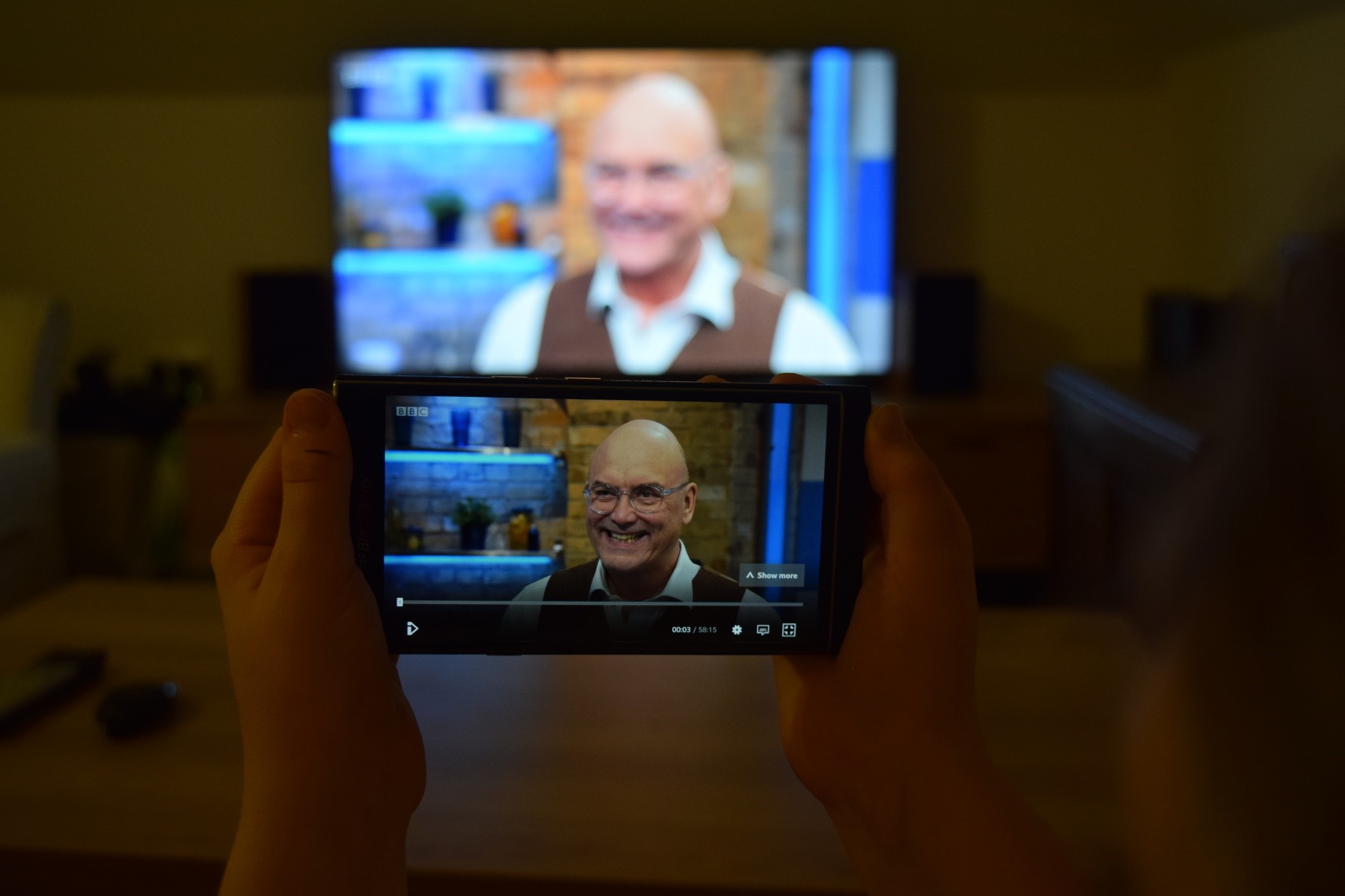
For marketers, producing different content for different devices is paramount. The length and format of advertising presented on different screens need to be considered. Whilst a smartphone held half a meter from the face fills roughly the same field of view as a TV, several metres away, it’s not possible to reach over and touch the TV screen or interact with it quickly. The TV remote is destined to decorate coffee tables for many years to come. The call to action of a video advert on a TV needs to be very different from a smartphone. Video – as our example highlights – is just one of many areas to consider.
Tip 1: Create different advertisements and content for different devices.
Web and apps
Advertising within websites and apps will also form part of a marketing strategy. Here the subtle and often overlooked differences between devices are even more critical.
A device streaming video must perform only one technical function – to ensure the video keeps playing smoothly. In contrast, a web page or app must appear to do many things at the same time. Here’s why.
Consider someone who taps a typical link to a news article from social media. The resulting web page must not only display the article content, permission consent, along with the rest of the publishers’ website, but also either authenticate the person or display some advertising.
Programmatic is often used to select the advertisement that will generate the most revenue for the publisher. Such an advert then needs to be displayed and monitored for viewability. Often, hundreds of different technology partners are involved. The advertiser and publisher are increasingly rewarded only when the advert is viewed by human eyeballs.
Two factors impact the user experience. The price of the device being used, and the technology used by the publisher and advertiser.
££££
Higher phone price tags attract better cameras, more memory, clearer and higher resolution screens and faster processors. A quick tour of a typical high street mobile retailer results in internet-capable mobile phones priced from £49 to over £1,200 SIM free.
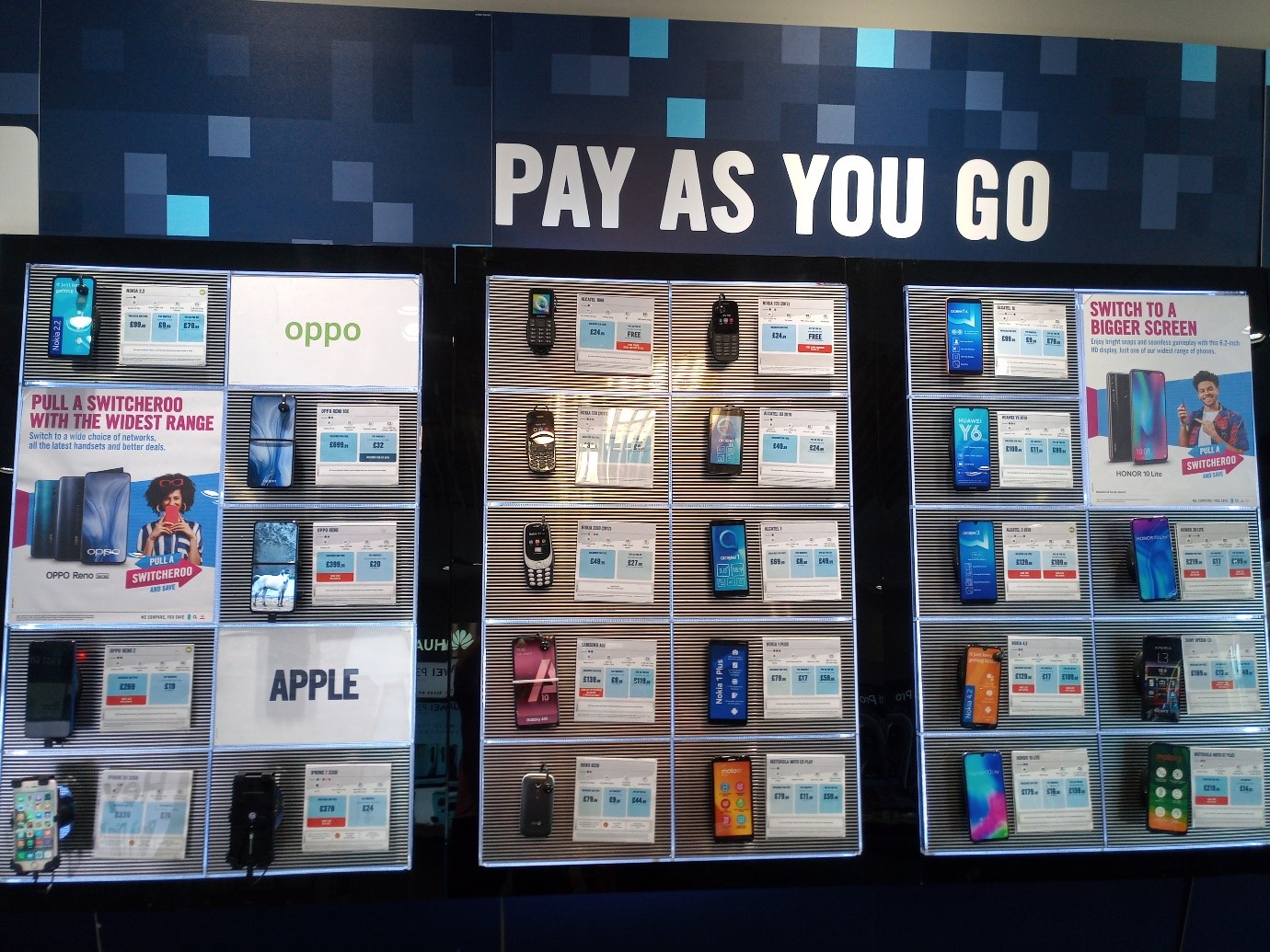
Fast, faster, fastest
Apple’s September 2019 announcement unveiling the iPhone 11 focused on CPU performance. The iPhone 11 is nearly twice as powerful as the Samsung S10+. Apple majored on this fact multiple times in what was an extremely well-curated and thought-through product announcement.
Unlike many other components of Apple products, the CPU is so important that they design and manufacture their own. If Apple cares about the CPU so much, shouldn’t marketing professionals?
With digital marketing, the phone, tablet or laptop’s processor speed is half the key to more rewarding experiences. Faster processors assemble the web page content and advertising faster.
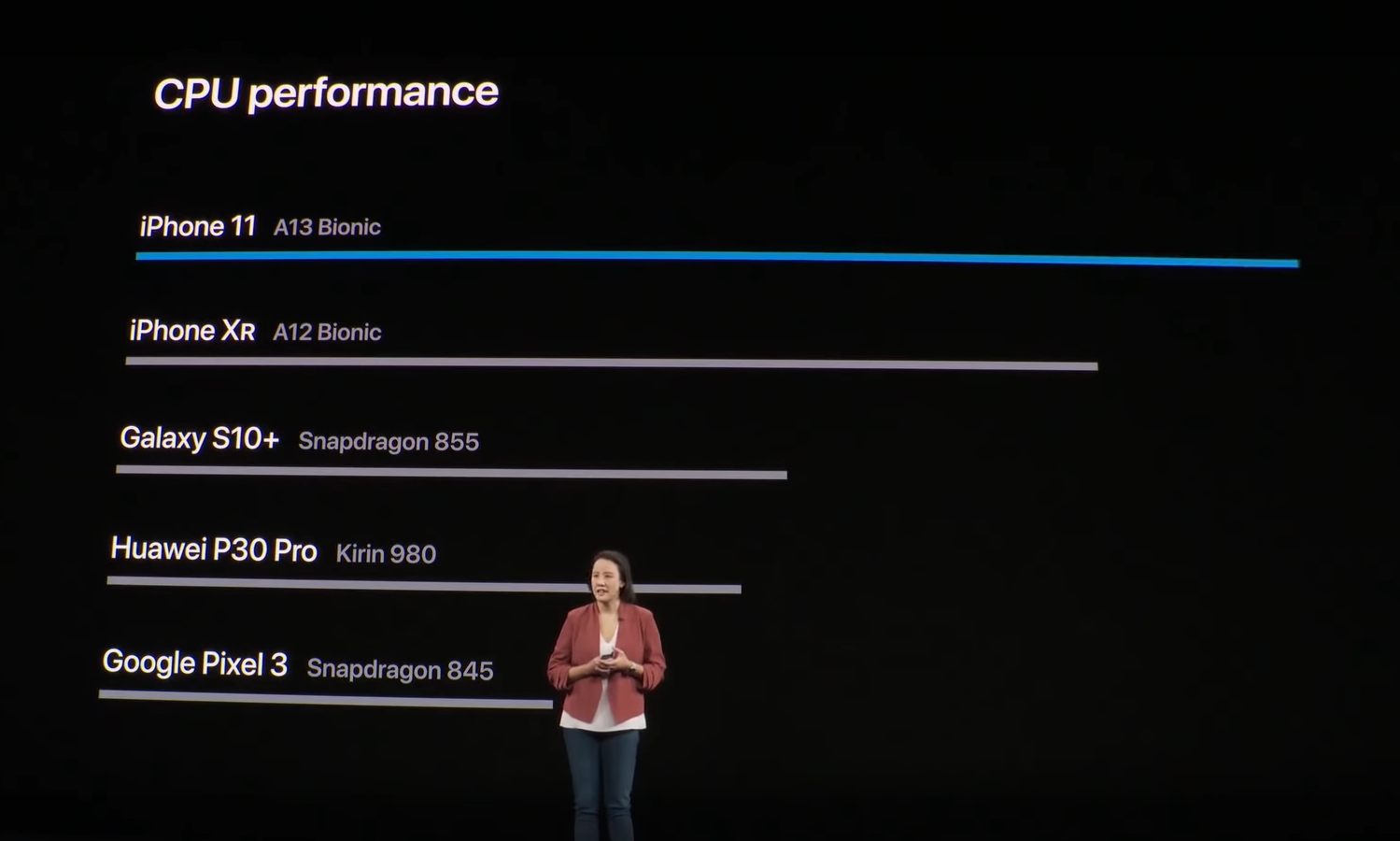
The other half to improved experiences is the web or app technology used by the publisher and advertiser. The less complex the advertising and the publishers’ digital technology, the quicker and more engaging the content and advertising. Publishers with slow technology or poorly designed apps and websites may not be noticeable on a high-end device but fail to perform on a low-end device.
Many marketing professionals buy mobile phones towards the upper end of the price range. They are therefore used to browsing the web with fast processors, lots of memory, and the best screens and cameras. They test websites, apps and adverts -and the technology delivering them – on these high-end devices. They never experience the web or apps from devices that are truly representative of the devices the general population use.
An iPhone 11 will assemble a web page and advertising roughly twice as quickly as a Google Pixel 3.
Tip 2 – Buy a cheap smartphone – and use it.
Networks
Popular myths around networks or carriers include “5G will be better” and “Wi-fi generates a better experience than cellular”. The truth is that today, the speed of the network has minimal impact on the performance of apps, websites and the associated advertising. The speed of the device’s processor and the complexity of the app or web technology are by far the most prevalent factors controlling a good or bad experience.
One “network” that does have an impact on the user experience is the ad tech network. The sooner the advertising can be displayed the better. More on this subject later.
Size matters
Screen size also has a significant impact on the performance of marketing across different devices. A high end device like the Apple 11 Pro Max has a 6.5-inch screen. The iPhone SE comes with a 4-inch screen. Both run iOS version 13. What’s 2.5 inches between friends?
Well in terms of square inches, the amount of screen available on the iPhone SE is 6.8 square inches. An iPhone 11 Pro Max is 16.1 square inches. A massive difference between two devices almost every marketer thinks of as being the same.

To illustrate the point, consider a publisher’s website which will typically display the following after a cookies/privacy acceptance full screen take over:
– App installation notice
– Branding with sign-in options
– Menu
– Leader article and headline
– Advertising
Using mirror.co.uk as an example, the iPhone SE is unable to display the headline, whilst the iPhone Pro 11 Max does a far better job.
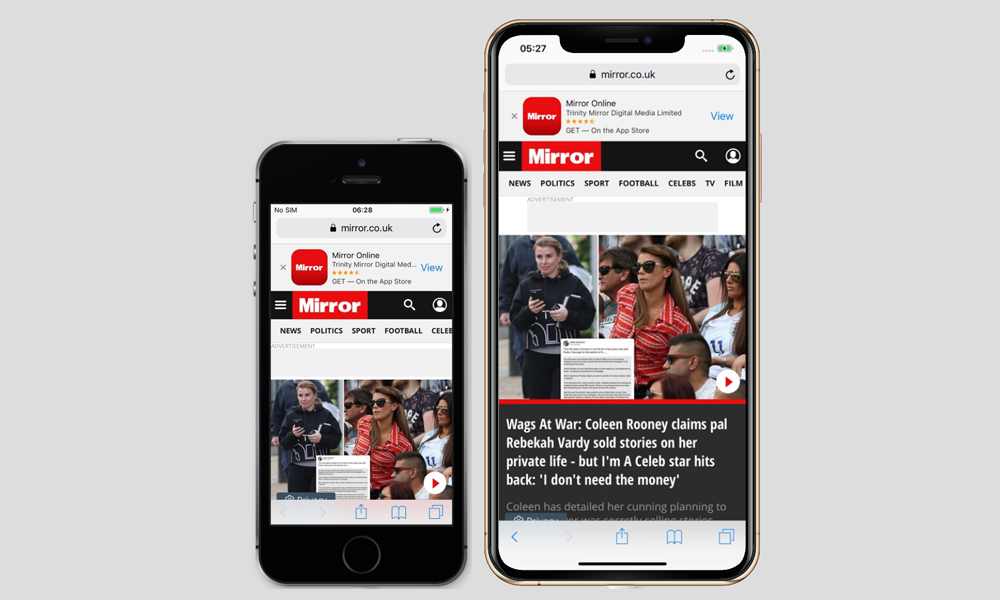
As human fingers don’t become smaller or larger depending on the screen size of the device, the virtual keyboard must occupy a minimum amount of physical screen space. Taking another UK publisher – telegraph.co.uk – as an example, the forgotten password page, with only a single text box for the password, loses the instructions when displayed on the small screen of the iPhone SE.
A registration page will typically contain many such fields for data entry and rapidly become confusing when displayed on the smaller screen. Further frustration results when a field is entered incorrectly as fingers are “fatter” on the smaller keyboard and validation errors appear out of view. No wonder abandonment rates are higher on mobile compared to larger screen laptops and desktops.
Tip 3 – Test on multiple screen sized devices, not just the one in your pocket
Personalise – who?
Subtle and overlooked characteristics of devices provide important clues to optimise and deliver a multi device strategy. Understanding the person using the device is another matter.
There are three techniques to understand the person. First and third-party data, and implied data based on usage.
First party
The best way to obtain the data needed to generate a personalised experience is to ask the person. Where there is a reason for the person to provide information about themselves, perhaps as part of receiving a service, this is easy to achieve. Armed with knowledge about age, gender and the like, adverts and articles can be targeted towards services and products likely to be of interest.
Unfortunately, in many situations, asking someone to provide any information about themselves is a source of frustration. How many people would be happy to provide their age and name before reading an article?
Third party
Where the person can’t be asked directly – or it wouldn’t be sensible to ask them – personal data may be available via other routes which could be used with the person’s consent. This is a complex subject and one covered elsewhere.
To read more about personal data from the Data and Marketing Association – Using third party data.
Fool’s game
Tracking an individual across multiple devices without their consent is a fool’s game. Avoid any solution or advisor that says otherwise. Any campaign or business which relies on such an approach is going to fail.
Tip 4 – Get consent. Don’t try and be clever or ignore the law.
Regulators
Regulators in Europe and the UK are cracking down on such practices. The General Data Protection Regulation (GDPR) and Privacy and Electronic Communications Regulations (PECR) are now part of the everyday business lexicon. The UK Information Commissioner Office’s (ICO) and PECR require non-essential cookies – such as those used for something as simple as website analytics – to be consented to. ( You can read read more on this in our Coping with the ICO’s updated cookie guidance article.)
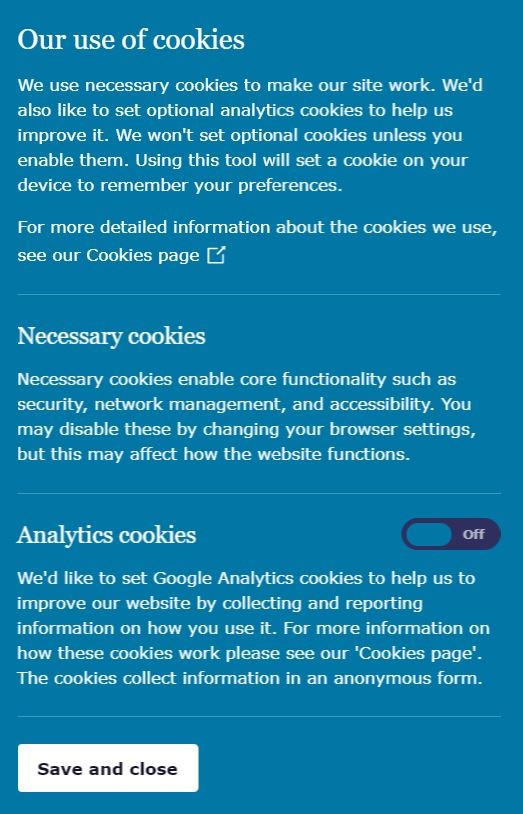
If the regulator is cracking down on something as simple as the analytics cookie, they’re certainly not going to ignore non-consensual tracking.
Tracking prevention
Whilst regulators enforce the law, browser and operating system vendors are modifying their technology to prevent multi device tracking, or indeed any tracking. During September 2019, Mozilla modified the default behaviour of Firefox to prevent tracking. Apple has modified iOS and Safari to enable tracking prevention by default. Read more in the links provided.
Most users won’t know these changes have been applied. At most, they’ll wonder why the holiday they were searching for on their iPhone stopped appearing as adverts on their PC. If it’s not noticeable to them then they won’t be interested in being tracked across device, or even trying to find out how to disable tracking prevention.
Sign me in
For users who like the convenience of sharing passwords and other commonly-used information across devices via auto-complete fields, they can log into the device or web browser and consent to sharing such data. For these users, a truly multi device experience becomes possible. They do, however, need an incentive to allow publishers, brands and marketers to do so. One such incentive is convenience.
The BBC’s iPlayer service is a particularly well thought-through example.
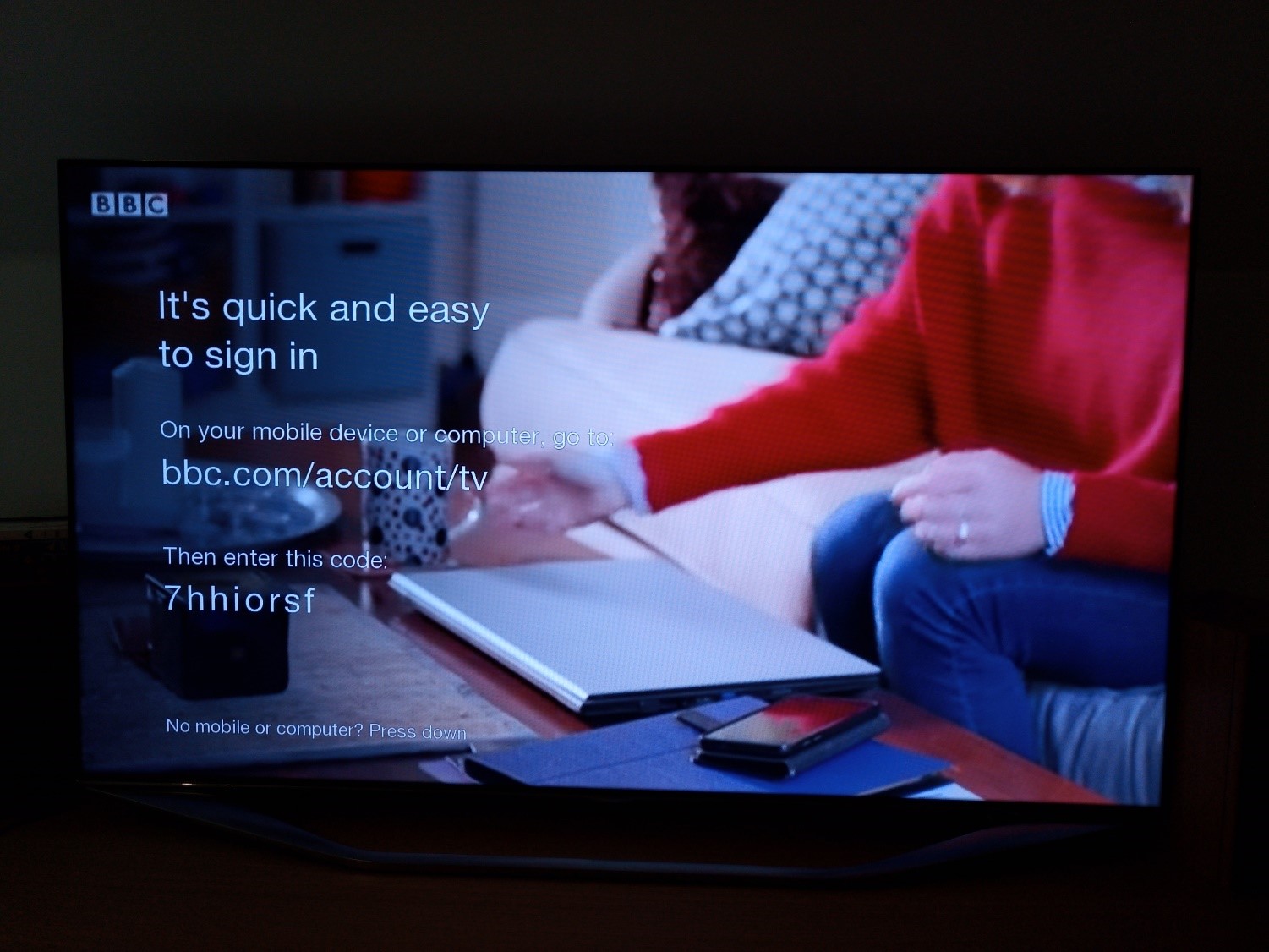
Rather than providing the option to enter the username and password for iPlayer on the TV the BBC simply displays a page with a code in front of an explainer video. The user goes to the website on a companion device such as a tablet, smartphone or laptop and logs in before entering the code.
Once the code is redeemed, the TV is signed in and both devices are now associated with the same account. People are not forced to enter a username and complex password via a TV remote controller (Ed: and inevitably entering it four times because the mandatory “special symbol” wasn’t correct). The BBC benefits by ensuring all iPlayer devices in a household are paired to at least one other device.
Tip 5 – Value consent. Don’t abuse it.
Implied data
There is a lot of subtle information which can be obtained with minimal consent. This implied data comes from the usage of digital services.
IP address
Every device accessing a digital service via the internet requires an Internet Protocol (IP) address. IP addresses vary by location and time. For example, the IP address of a domestic dwelling might vary every few months, whilst one at a retailer will vary annually. At a given point in time, public IP addresses are unique and never shared. The internet wouldn’t function if they weren’t.
If all devices in a location are using the same public IP address, it is not always possible to tell the devices in the location apart. When combined with a consensual tracking cookie or app device ID – a unique code remembered by the device – it becomes possible to determine with a reasonable degree of certainty which devices regularly appear at the same IP addresses. This information can then be used to infer an association between multiple devices.
An IP address is personal data under GDPR in certain conditions. As such it is wise to explain how an IP address will be used as part of an opt-in privacy policy.
Behaviour
Implied data can be enhanced further by overlaying the topics of interest to individuals.
Consider a household where the TV is interacting with a video streaming service. The TV is often used to watch content related to technology and science fiction. There is also a smartphone which can be inferred by IP address as belonging to the same household. With the right agreements in place between the service providers and user, the smartphone could be targeted with technology and science fiction content.
Pitfalls
The problem with implied data is that it’s implied! Making the data work is complex, and technology or regulatory changes can make the whole thing fall apart. Explaining the lack of certainty to advertisers can be challenging. As such, it should be used with caution. Ultimately, explicitly requiring sign in and registration across multiple devices is the most robust and future-proof approach to serving multi device experiences.
Tip 6 – Design for sign in. Build a strong relationship.
Platform – how?
TVs, smartphones and laptops are different. People engage with digital services with varying degrees of love, altering how much they trust them or are prepared to share data. Rewarding multi device digital experiences only work when the device, user and technology platform(s) operate in harmony. This section covers the technology platforms.
Keep It Simple Stupid
A platform provider cannot control the device in a users hand or in their home. They can, however, understand them and deploy solutions which cater for diversity.
According to BuiltWith – a popular tool to understand the technologies used to delivery websites – mirror.co.uk utilises 262 technology vendors and technologies. The following scrolling table lists them.
| Netmining | Chartbeat | Omniture SiteCatalyst | Krux Digital |
| Optimizely | Everest Technologies | Soasta mPulse | Dynatrace |
| LiveRamp | Hotjar | IgnitionOne | Rapleaf |
| Lead Forensics | Clicksco | Quantcast Measurement | comScore |
| MediaMath | VisualDNA | Lotame Crowd Control | Facebook Domain Insights |
| Google Analytics | Dotomi | 33 Across | Moat |
| Global Site Tag | Typeform | Google Font API | Facebook Like Button |
| Twitter Tweet Button | Facebook Like | Gigya | Opta |
| Getty Images | Accelerated Mobile Pages | Google Tag Manager | Google Custom Search |
| Lijit Widget | Smart App Banner | GDPR Consent Management Platform | Cart Functionality |
| Facebook Domain Verification | CloudFront | Facebook CDN | Akamai |
| GStatic Google Static Content | AJAX Libraries API | jsDelivr | Viewport Meta |
| Mobile Non Scaleable Content | IPhone / Mobile Compatible | Apple Mobile Web Clips Icon | Pound Sterling |
| Euro | Japanese Yen | Unruly Media | html5shiv |
| Facebook SDK | Facebook for Websites | Modernizr | jQuery |
| SWFObject | Google API | Boomerang | Murmur Hash |
| Webpack | HTML5 History API | Preact JS | Openads/OpenX |
| ContextWeb | Pubmatic | Simpli.fi | DemDex |
| Connexity | Rubicon Project | Google Adsense | AppNexus |
| SiteScout | Rocket Fuel | Turn | Content Delivery Network |
| The Trade Desk | eXelate | Criteo | DoubleClick.Net |
| Integral Ad Science | IponWeb BidSwitch | Yahoo Small Business | Burst Media |
| Google Publisher Tag | Taboola | OnScroll | Omnitag |
| Adobe Audience Manager Sync | Prebid | Amazon Ad System | Amazon Associates |
| Ads.txt | Google Direct | Teads Direct | AppNexus Direct |
| AppNexus Reseller | PubMatic Direct | RubiconProject Direct | Taboola Reseller |
| ContextWeb Reseller | RhythmOne Reseller | ORC International Direct | OpenX Direct |
| Google Reseller | SmartAdServer Reseller | Kargo Direct | OpenX Reseller |
| AdYouLike Direct | Sovrn Reseller | PubMatic Reseller | 33 Across Direct |
| SpotXChange Reseller | Amazon Reseller | LKQD Reseller | AOL Reseller |
| RubiconProject Reseller | Criteo Reseller | FreeWheel Reseller | Fyber Reseller |
| Tremor Video Reseller | YuMe Reseller | Improve Digital Reseller | ORC International Reseller |
| Lijit Reseller | GumGum Reseller | Nativo Reseller | AdYouLike Reseller |
| ContextWeb Direct | Converstand Media Reseller | Beachfront Reseller | Spoutable Direct |
| Taboola Direct | DistrictM Direct | Sonobi Reseller | Bidfluence Reseller |
| ShareThrough Reseller | AOL Direct | SpotXChange Direct | LoopMe Direct |
| Exponential Direct | Triple Lift Direct | Permutive | Drawbridge |
| Header Tag by Index Exchange | Yahoo Ad Sync | Beeswax | SkimLinks |
| Index Exchange | Improve Digital | IndexExchange Direct | IndexExchange Reseller |
| Cedato Reseller | Sovrn Direct | Lijit Direct | Adform Direct |
| RhythmOne Direct | AdGear | SpringServe Reseller | Improve Digital Direct |
| Brightcom Direct | 33 Across Reseller | DistrictM Reseller | RUN Ads |
| SpotXchange | LoopMe Reseller | Tremor Video Direct | Sonobi Direct |
| LifeStreet Media | Bidtellect | Adform Reseller | Comet Cox Media Reseller |
| GumGum Direct | LiveIntent Direct | Exponential Reseller | Converstand Media Direct |
| Beachfront Direct | ShareThrough Direct | Perform Group | Google Consumer Surveys |
| Adnami | pixfuture Direct | Vertoz Direct | Undertone Direct |
| Switch Concepts Direct | The Trade Desk Reseller | Crimtan Reseller | Quantcast Reseller |
| SSPHighway Reseller | DAConsortium Reseller | Netseer Reseller | Coull Reseller |
| optAd360 Direct | Switch Concepts Reseller | Tappx Reseller | Zemanta Reseller |
| Bidtellect Reseller | Native Ads Reseller | AnyClip Direct | Experian Reseller |
| Insticator Direct | Somoaudience Reseller | Somoaudience Direct | Mobile Ad Trading Direct |
| Amazon Direct | Media.net Direct | Lockerdome Direct | Teads Reseller |
| ucfunnel Direct | AdKernel | Outbrain Direct | Telaria Reseller |
| AdMan Reseller | adtelligent Reseller | Imonomy Direct | Inneractive Reseller |
| RealVu | Imonomy | Criteo Direct | SmartAdServer Direct |
| GroundTruth Reseller | Synacor Direct | ucfunnel Reseller | OneTag |
| Sovrn | bRealtime | FreeWheel Direct | Smaato Direct |
| Plista Direct | Carambola Direct | FirstImpression Direct | Revcontent Direct |
| Yahoo Direct | Primis Direct | Outbrain Reseller | AdMan Direct |
| MaxPoint Interactive | StackAdapt | Loopme | Eye View Digital |
| Adelphic | Google Apps for Business | SPF | Amazon |
| Amazon Route 53 | SSL by Default | Amazon SSL | nginx |
| Varnish | Apache | Pingback Support | RSS |
| Max Width | Akamai Edge | Amazon S3 CDN | Amazon CloudFront |
| MSN/Bing Webmaster | Google Webmaster |
A publisher optimised for multi device such as news24.com – the largest media organisation in south Saharan Africa – uses 37 technology vendors and technologies. The following scrolling table lists them.
| Alexa Certified Site Metrics | Effective Measure | Facebook Domain Insights | Alexa Metrics |
| Facebook Pixel | Facebook Conversion Tracking | Smart App Banner | Google Tag Manager |
| ASP.NET | IPhone / Mobile Compatible | Viewport Meta | CloudFront |
| Cloudflare | Facebook Graph API | jQuery | Unveil |
| Facebook for Websites | Facebook SDK | Facebook Custom Audiences | Polar |
| Google Publisher Tag | DoubleClick.Net | Google Adsense | UTF-8 |
| HTML5 DocType | Conditional Comments | HTML5 Boilerplate | Meta Description |
| Meta Keywords | Javascript | Open Graph Protocol | Web App Manifest |
| Cascading Style Sheets | IFrame | HTML 5 Specific Tags | Report URI CSP |
| Content Delivery Network |
The less complex something is the better it performs. Comparing News24 and Mirror across all devices based on metrics of visit duration, pages per visit and bounce rate the simpler News24 is the clear winner.
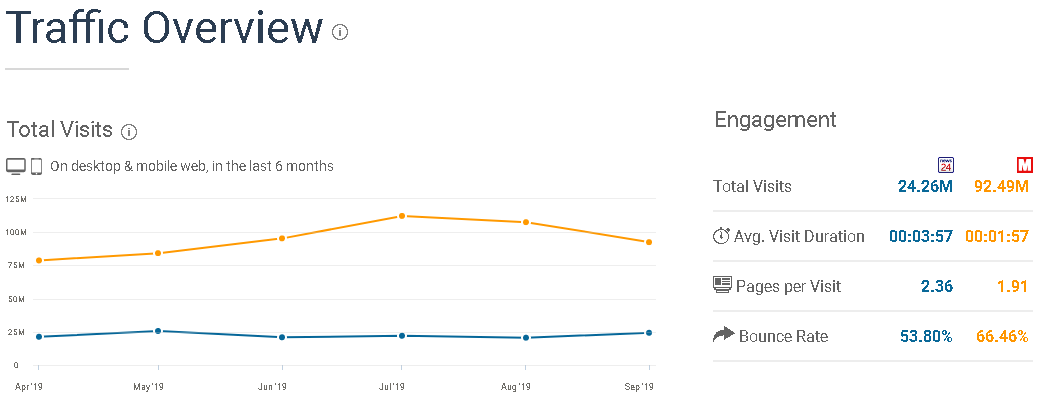
Page load time
Consider a common web metric such as the time taken to load a web page. The most important factor which impacts how quickly the page will load and engage with the user is the workload the web page requires from the device and therefore the time taken for the device to complete that workload. Asking a weak device to perform a task it’s not capable of performing well is folly.
When the price of a device is added to Google Analytics there is a clear correlation between page load time and the price of the device. More expensive devices have faster processors and therefore the web page loads quicker.
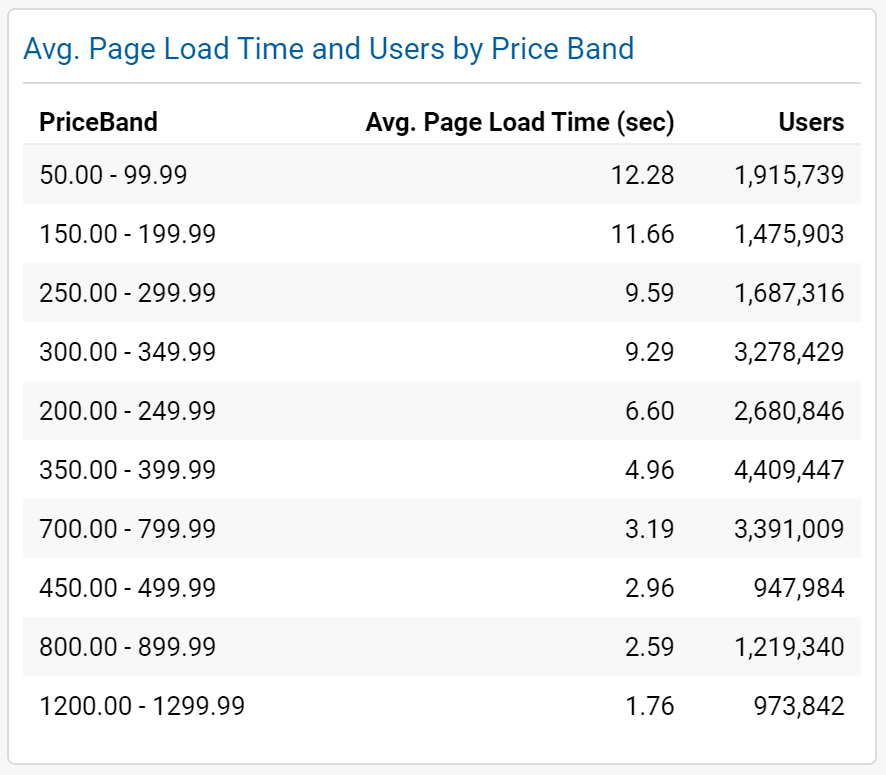
Google Analytics alone does not reveal this correlation. Instead page load time for all mobile devices is averaged out removing valuable insights. Device price and chipsets are, however, the most significant data point repeatably missed by digital analysts investigating page load time.
Responsive Web Design
Many publishers have adopted Responsive Web Design (RWD) to deliver a single web page to every device. RWD has failed to deliver revenue benefits to publishers. Designers and developers continue to get excited by it and argue to the contrary.
But if RWD worked in ad tech and publishing, why is Accelerated Mobile Pages (AMP) needed? (Ed: isn’t the clue in the name “Mobile”)
Why do Google and other major web businesses serve different content and interfaces to different devices? The subject is more complex than this 101 allows. Read more about the shortcomings of RWD and the missed revenue opportunities here.
Tip 7 – Advertisers must start dropping publishers with poorly-performing websites – start with mirror.co.uk
Measure performance
Google provides a handy performance measurement tool. Titled “Pagespeed Insight” – and available at https://developers.google.com/speed/pagespeed/insights – it’s as easy as entering a web address and obtain performance scores out of 100. For the technically minded, there are plenty of tips concerning areas of improvement.
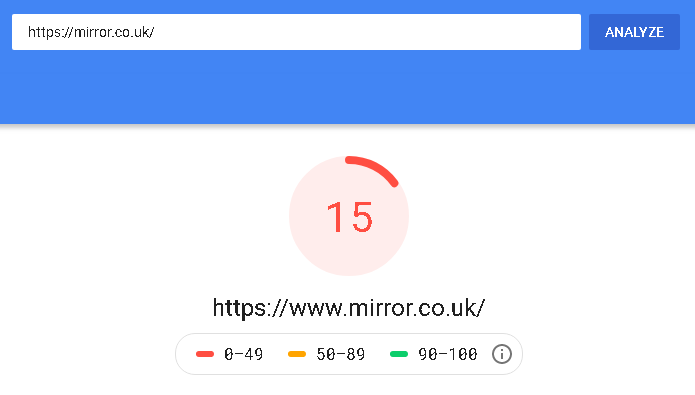
Given how simple obtaining a useful performance benchmark has become, selecting only technology platforms that have a positive impact on performance is essential when considering the multi device world. Just because it performs well on an expensive iPhone 11 Pro doesn’t mean it’s performing well everywhere.
Tip 8 – Don’t pay technology partners unless they positively contribute to performance.
Incomplete ad tech
Many solutions for advertising targeting and ad operations simply group devices by crude dimensions such as device type, OS and browser, which are no-longer particularly meaningful.

Mid 2019, there were over 55,000 active models of device consuming digital content globally. When combined with browsers and operating systems, over 1,328,477 device combinations would need to be considered by ad operations if they were to be truly effective!
Ad tech solutions that treat devices as a simple list of vendors and models are inflicting friction on operators, and are practically unusable. Super simple targeting and analysis can be achieved by grouping by price, age, chipsets, physical screen and other meaningful dimensions.
Artificial Intelligence
AI is now an important component of marketing strategy.
Persona.ly – a DSP – recognised at the beginning of their AI journey that the results from the AI were only going to be as good as the quality and breadth of the data fed to the AI. They didn’t copy other DSPs or ad tech players, or ask their customers what data points were needed, they fed the AI everything with the highest possible quality.
As a result Persona.ly was able to increase performance by 15 per cent, improving lifetime value for advertisers and increasing yields for publishers. They did this with a geographical broad, accurate and authoritative device data solution from 51Degrees – the company sponsoring this 101.
51Degrees
Find out more about device detection on 51Degrees’ website and learn why so many businesses from eBay, Tencent, Disney, Fandom, News 24, HSBC, Unilever, Sitecore, Opentext, Adform, Cento and AcuityAds incorporate our data services.
51Degrees contains a broad set of device level data, as outlines in the table below:
|
Battery – capacity, times |
Model – manufacturer, OEM, name, code, variants Pricing – standardised categories Processors – SoC, CPU, GPU & vendors Ratings – IP, certifications Screen – sizes, type SIMs – type, size, number TV – power, contrast, energy Images – thumbnails |
Tip 9 – Demand high quality device level data from 51Degrees.
Legacy ad tech
Many device intelligence solutions used by ad tech were designed in the last decade pre-iPhone and Android. Device intelligence is a niche and their vendors appear to have lost interest in developing alternative products unrelated to real-time device intelligence. Many major ad tech platforms still utilise these solutions. Why?
51Degrees was formed in 2009 as an open source project and started operating commercially in 2011. Many programmatic ad tech technology platforms were created before 51Degrees was established. Since 2011, 51Degrees has gained five granted patents in the field on both sides of the Atlantic.
51Degrees were the first to support applications, and to introduce price band and chipset data among many other firsts. Some ad tech players have made the move to 51Degrees. Others will, when publishers and advertisers realise they’re missing out on revenue or wasting money. Ad tech platforms, especially those involved in programmatic auctions, gain significantly from the lower operating costs associated with more efficient algorithms.
Tip 10 – Advertisers, stop spending money with ad tech partners who think iOS is more valuable than Android. It’s not and you’re missing out.
Advertisers should stop spending money with publisher and ad tech platforms that do not reliably identify device segments such as age, price band, screen size and chipsets. If the publisher does not serve advertising quickly and smoothly, no one is rewarded.
Summary
This multi device 101 explained how devices vary by price and why many established analytics techniques and digital technologies fail to handle these differences. To truly embrace multi device, a different mindset is needed. A mindset that is focused on business performance rather than being contrained by technology.
Once an open performance focus mind considers all the factors impacting business performance and is prepared to challenge and do something about it, real progress is possible. Those profressionals and businesses that can make the shift will benefit from more rewarding digital engagements.
To find out more about the rewards that await businesses embracing multi device have a chat with the folks at 51Degrees.
Top tips
Device
1. Different advertisements and content for different devices.
2. Buy a cheap Smartphone – and use it.
3. Test on multiple screen sized devices, not just the one in your pocket.
People
4. Get consent. Don’t try and be clever or ignore the law.
5. Value consent. Don’t abuse it.
6. Design for sign in. Build a strong relationship
Technology Platform
7. Advertisers must start dropping poorly performing publishers – start with mirror.co.uk
8. Don’t pay technology partners unless they positively contribute to performance
9. Demand high quality device level data from 51Degrees
10. Advertisers, stop spending money with ad tech partners that think iOS is more valuable than Android. It’s not and you’re missing out
















